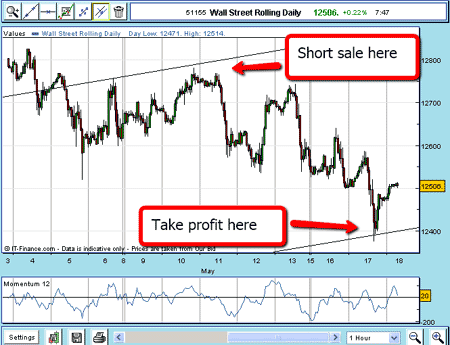How to find your next price target using tramlines
Recent action in the Dow Jones index has provided a near-textbook case of target-spotting for John C Burford. Here, he explains how tramlines help him find entry and exit points for trades.
Recent action in the Dow Jones index is giving me a near-textbook case of target spotting.
Below is the situation as of late April, when the market had rallied into new high ground following the 18 April low:

(Click on the chart for a larger version)
MoneyWeek
Subscribe to MoneyWeek today and get your first six magazine issues absolutely FREE

Sign up to Money Morning
Don't miss the latest investment and personal finances news, market analysis, plus money-saving tips with our free twice-daily newsletter
Don't miss the latest investment and personal finances news, market analysis, plus money-saving tips with our free twice-daily newsletter
The first tramline I drew on this daily chart was the central one as it offered several good touch-points (and some overshoots, which is expected).
Then, I drew the upper one which I wanted to pass across the early April highs.
Finally, I drew a line equidistant and parallel across the bottom for my suggested lower tramline. Note that it passes perfectly across the 18 April low.
With this evidence, I shall use these tramlines as my working set.
Let's have a look in close-up:

(Click on the chart for a larger version)
I have marked the important 18 April low with a red arrow.
So, as of late April, the market had bounced off my lowest tramline and was heading up towards my central tramline. Odds are that it would make it to the central tramline, at least.
What's happening now?
Let's have a look at the situation as I'm writing this on Wednesday 18 May:

(Click on the chart for a larger version)
The market did indeed rally to my central tramline and beyond. But when it reversed and plunged beneath the line on 5 May (note the large red candlestick), that was a bearish sign and a short trade could be opened on the break.
But if you missed that one, there was a second chance (there usually is!).
Following the May 5 move down, the market rallied right back to the underside of the line and then performed a 'scalded cat bounce' back down.
That was another opportunity for a short trade.
Finding the right target price
So, the market was heading down where should your target be?
At the lowest tramline, of course!
And that is exactly where the market stopped yesterday 17 May (marked by yellow arrow).
Incidentally, this level is also the Fibonacci 38.2% retrace of the big wave from the March 11,500 low to the 12,900 2 May high yet another reason to suspect good support.
Here is the trade on the hourly chart:

(Click on the chart for a larger version)
A short-term trade taken at the 12,740 area and closed out yesterday at the 12,400 area would have produced a profit of £340 per £1 spread bet.
Now, this kind of trading is not for everyone, as it involves keeping a close eye on the markets, especially for your entries. But when you have an entry and have your tramlines in place, you can set a limit order to take profits, and get on with the rest of your life.
Naturally, you will need to keep your protective stops in place just in case the market does not behave.
NB: Don't miss my next trading insight. To receive all my spread betting blog posts by email, as soon as I've written them, just sign up here .
Get the latest financial news, insights and expert analysis from our award-winning MoneyWeek team, to help you understand what really matters when it comes to your finances.
John is is a British-born lapsed PhD physicist, who previously worked for Nasa on the Mars exploration team. He is a former commodity trading advisor with the US Commodities Futures Trading Commission, and worked in a boutique futures house in California in the 1980s.
He was a partner in one of the first futures newsletter advisory services, based in Washington DC, specialising in pork bellies and currencies. John is primarily a chart-reading trader, having cut his trading teeth in the days before PCs.
As well as his work in the financial world, he has launched, run and sold several 'real' businesses producing 'real' products.
-
 How to invest in water - and should you?
How to invest in water - and should you?The ultimate in liquid investments, water companies offer investors’ portfolios a range of benefits. How can you invest in water?
-
 Act now to avoid inheritance tax on your pension with this one simple change
Act now to avoid inheritance tax on your pension with this one simple changeA quick and easy paperwork change could avoid your children paying inheritance tax on your pension if you act now. Here’s how.